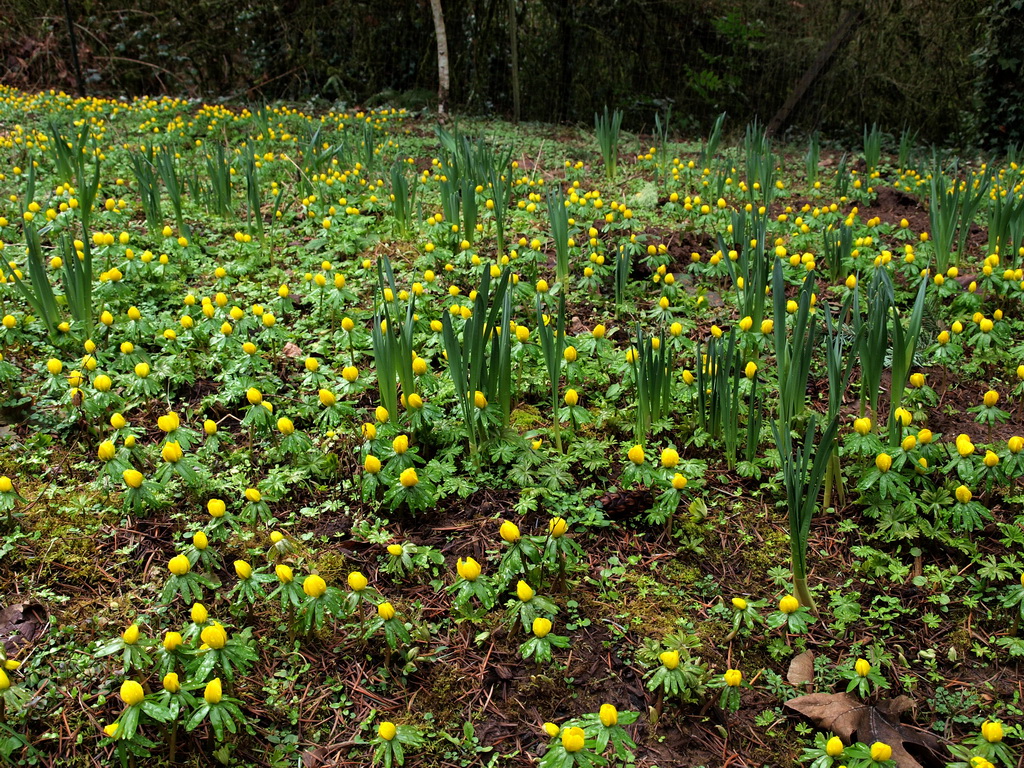March can be a real teaser month around here. It can be sunny and warm for a few days. Out come the shorts, hiking shoes, cameras, and maps. Then, wham, the jet stream moves and the next few days are cold and rainy here in the valley, with snow in the mountains! Although this year I must admit overall, it has been pretty mild and more favorable for us wildflower searchers. There are not many wild things blooming here in the western valleys yet, but I did see a few Western Trillium the other day.
Several of the local wildflower books and web sites give the start of the season as mid-March for the Eastern Columbia River Gorge. It tends to be warmer and drier out there, east of Hood River. So with that in mind, we waited for a sunny day and picked two short hikes to see what was happening there.
First stop is the Tom McCall Nature Preserve at Rowena, which is about 6 miles east of Hood River. It's about a two hour drive from our house and as we arrive the cool morning has warmed up a bit. We've been here several times before, but only in summer when it is mostly dry and all the plants are pretty much done blooming. The views are nice any time of year, both east and west. It's a week-day, so there are only two other cars in the parking area.
It can be quite windy in this area, but today, thankfully, there is none. There are a few short loop trails out to the cliffs that overlook the river so I head out with camera in tow. The trails and ground are still a bit damp from recent rain. Several small seasonal ponds hold trapped water.
 |
| Looking northeast at Lyle from Rowena |
 |
| Grass Widows on the Rowena Plateau |
Two larger ponds seem to be year around features and may be spring fed. Many oak trees grow around these ponds, but at this date they have no leaves.
 |
| Large pond on Rowena. Oaks and shrubs still leafless. |
After walking all over Rowena, it was time for lunch and coffee at the viewpoint, located just across the road from the preserve. While there I chatted with a couple of cyclists who were riding from Hood River. From here I took the historic highway 30 another six miles east to The Dalles. It's a nice drive and I see why the bikers like it! In the Dalles, we cross the Columbia and turn back west and head for the Lyle Cherry Orchard trailhead, about 10 minutes down the road.
At this trailhead, only three other cars are in the lot - ah the joys of weekday hikes! The trail gains about 1000 feet in the first mile, through a small gorge of oaks and rocks, going up the mesa with many long switchbacks. The river view to the east is picture-perfect and with no wind the river is like glass!
 |
| About 1/3 of the way up, looking east. |
 |
| About 1/2 way up. |
 |
| Near the high point, looking west. Rowena plateau at left, across river. |
The oaks up on the plateau are old, but short and weather-beaten. They have no leaves at this point. I follow the winding trail another mile but don't see any new wildflowers.
Here's a run-down of the wildflowers seen on the two locations:
Grass Widow (Olsynium douglassii)
The first thing we notice are the Grass Widows popping up everywhere we look. These intensely purple native flowers are often the first bloomers out here. There are huge swaths of them in the damp areas along the trail. Each bloom is about an inch wide with six petals. Most were seen at Rowena on this outing.
See the separate post on Grass Widows.
Yellow Bells (Fritillaria pudica)
These native flowers are smaller than the Grass Widows and do actually resemble tiny, half-inch bells that hang down from their stalks.
Friitillaria is a member of the Lily family and includes about 100 other species, several of which also grow naturally in the Columbia Gorge. Just a few seen at both Rowena and Lyle.
 |
| At Rowena |
 |
| At Lyle |
Spring Gold (Crocidium multicaule)
These small annuals are, not surprisingly, members of the sunflower family. They are also called Gold Stars and are another early blooming plant, capable of spreading over entire hillsides. We saw these at Rowena and Lyle.
Columbia Desert Parsley (Lomatium columbianum)
Another member of the Carrot family and the leaves somewhat resemble your garden variety parsley. The showy purple blooms open to an umbrella shape up to 3 inches across. These were new to me and I was struck by the nice contrast between the gray-green leaves and deep purple flowers. Columbia Desert Parsley is endemic to Oregon and Washington, so it's a real native! We saw most of these blooming at Lyle.
Smooth Desert Parsley
The leaves on this parsley are greener than the Columbia one above. The bright yellow flowers were just barely starting to open along the Lyle Cherry Orchard trail.
And last but not least, here is why many trailheads now have those boot brushes available for you. This is a Filaree or Stork's Bill (
Erodium cicutarium), is a native of Eurasia, and now invades most of North America. It was growing right along the cherry orchard trail.
 |
| It's a member of the Geranium family! |















































